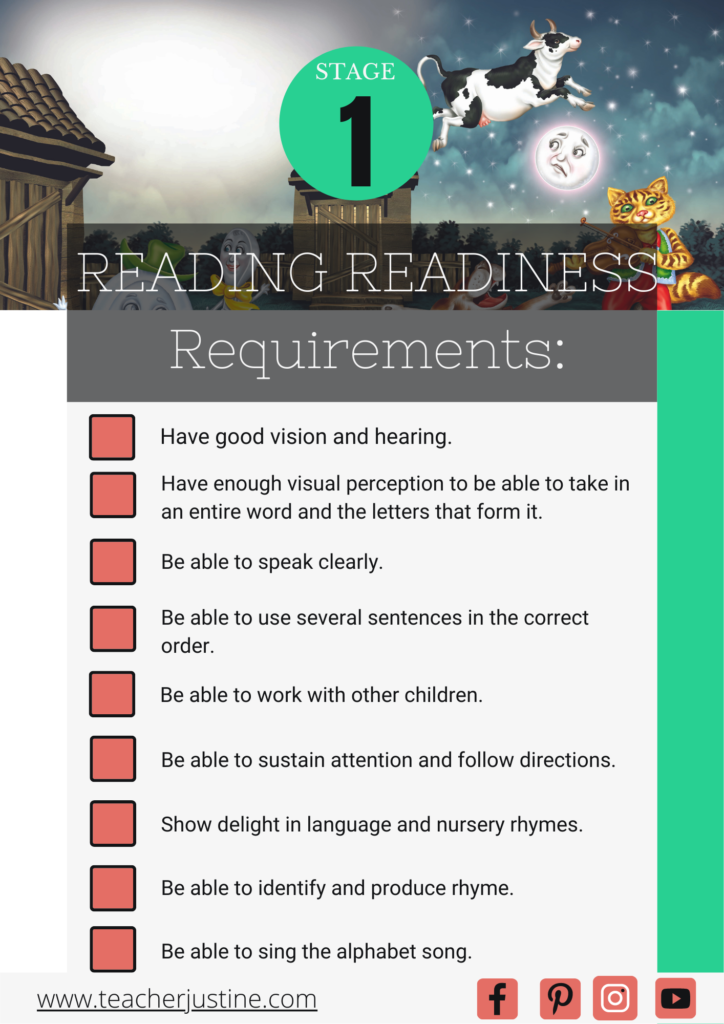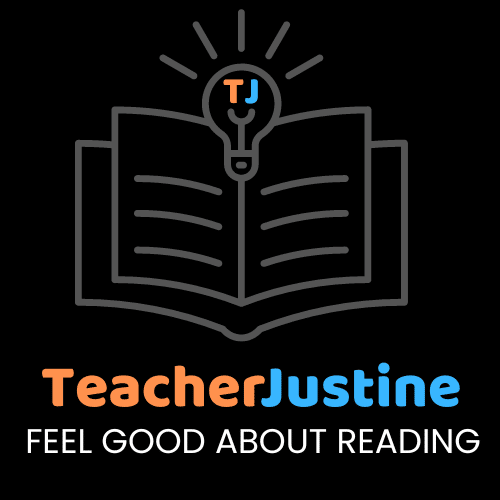Teacher Justine contains affiliate links and is a member of the Amazon Services LLS Associates Program. If you make a purchase using one of these Amazon links, I may receive compensation at no extra charge to you. See my disclosure policy for more information.
5 Reading Readiness Actions You Must Do with Your Child
Reading readiness is oral language comprehension
Reading readiness is the first stage of reading. It starts before birth and goes until age 6 or 7. Reading readiness is simply developing strong oral language abilities. Your baby and child will develop their oral language skills naturally, but you can influence the quality of their learning by being intentional. When you provide them with quality oral language experiences, you set them up for success in stages 2 (decoding) and 3 (comprehension) of reading. Here are 5 reading readiness actions to help your child develop strong oral language abilities.
IF YOUR CHILD IS
Struggling with Reading
We can help
1. Speak, sing and coo to your baby and toddler
Did you know a baby can learn the sounds in any language until about age one? Then, in their first year, they gradually start developing neural pathways just for the language they are surrounded by. They start to lose the ability to learn sounds of other languages and start becoming experts in the sounds of their native language.
You can help them become experts in the sounds of their native language by using babyese. This is the high pitch sing-song voice we naturally use for babies and pets. Cooing and singing engage the baby more than normal intonation and it helps them to learn language by exaggerating the sounds.
When we speak babyese to our babies, we stretch out the vowels and say them more clearly. This helps the baby hear and imitate the smallest units of speech in a language. These are called phonemes. By speaking babyese, singing, and cooing, you are helping your baby develop phonemic awareness. Phonemic awareness must be in place to learn to read.
2. Teach your toddler and preschooler nursery rhymes
Do you still remember Humpty Dumpty and Baa Baa Black Sheep? All children and parents used to know the Mother Goose nursery rhymes. Now, many kids in kindergarten have not learned nursery rhymes. This is too bad and explains why many children have underdeveloped rhyming and phonemic awareness skills.
Nursery rhymes are filled with unusual rhyming words and sounds. Children love listening to and reciting nursery rhymes over and over. They will ask for the same one again and again.
This might get old for you, but it is so good for their oral language development. They are learning to identify and manipulate words, syllables, and phonemes. Playing with nursery rhymes develops their phonemic awareness.
3. Sing the ABC’s with your preschooler
We all know that knowing the sounds the letters make is important to learn to read, but so is knowing the names of the letters. In my one-on-one tutoring, I include spelling right from the beginning. To spell, the children need to know the names of the letters.
When children first start singing the ABCs, they don’t know they are saying the individual letters. They are just singing a song and often blend many of them together. Later, when they start to realize these are actual letters, make sure to slow down so that they articulate each letter. Also, point to the letters as they sing so that they start associating the name of the letter with the symbol.
Often young children only know the alphabet when they sing them in order in the song. As they get closer to age 5, make sure to point to them out of order so they learn the letter names without singing the song.
4. Read lots of books to your child
Listening to stories is an excellent way to help your child develop their oral language vocabulary. This will be so important for them later when they begin to decode words. When you already have a large vocabulary, you can sound out a word much more easily and then you can map the spelling to the meaning and recognize it the next time.
Also, try memorizing fairy tales and telling them to your child instead of reading them. Oral storytelling is a lost art but it is very engaging. I learned how to do this during my Waldorf teacher training. Telling the original Grimm’s fairytales to children is a little controversial because some of them are very gruesome. But, the old fairy tales are so good for children to develop their oral vocabulary and sense of story.
Children that have large vocabularies in first grade will have better reading comprehension in 11th grade than children who can decode well in first grade but don’t have a large vocabulary. Oral language development in stage 1 comes both before decoding and continues long after in stage 3. Oral language comprehension is half of the reading comprehension equation!

5. Be intentional with your child’s oral environment
What sounds does your child hear inside the home? What sounds does the child hear outside the home? Try to be intentional with the quality of sounds your child is exposed to. Don’t leave the tv on all day when your child is around. These sounds are not pleasant.
Take them into nature frequently to hear soothing, calming sounds. The other day I was walking down a neighborhood street. For the first part of it, I was aware of the loud sound of leaf blowers used by the gardeners. I kept walking and suddenly the leaf blowers had stopped and I became aware of the sounds of a creek and the wind in the trees. My entire mood changed and I felt so renewed. Imagine how sounds affect young children.
Stage one, Reading Readiness, is complete
When you do all these reading readiness actions with your young child, they will have mastered the first stage of reading and be ready to learn to read. This means that they will have solid oral language comprehension skills and abilities.
When should you get worried?
In the old days, you could wait until age 7 for your child to become ready to read. But now children entering kindergarten are expected to be able to do things that used to be required of first graders.
You might be worried that your child entering kindergarten or first grade has not mastered reading readiness. You might have noticed that they do not know all their letter names and sounds. Or you may have noticed that they can’t recognize or produce words that rhyme.
You might be thinking “Oh no, I did not take all these reading readiness actions like teaching them enough nursery rhymes” or “I did not tell them enough stories”.
Or you might be thinking “I took all these reading readiness actions and they still don’t know the ABCs and they can’t rhyme.”
It is good that you are noticing these things now. If for some reason your child has not yet mastered phonemic awareness and letter names by age 5, then they should begin a systematic approach that starts with teaching phonemic awareness and letter names, and then adds in phonics, sight words, and spelling.

My story and a new development
In other posts, I have told my story about my daughters and learning to read. I started out enamored with Waldorf education and thought it was the answer to everything. I became a Waldorf teacher and raised my young children with lots of singing, stories, and nursery rhymes.
I believed that children learn to read naturally and that you just have to give them enough time. However, when my second daughter was still not reading at the beginning of third grade, I had her assessed and transferred her from the Waldorf school to a public school.
She qualified for an IEP with a specific learning disorder. I thought this was code for dyslexia. She responded well to the direct, explicit, systematic intervention she received. So I became very interested in phonics and I have now realized that children do not learn to read naturally and that most reading difficulties can be solved by systematic phonics instruction.
I do still believe that Waldorf early education is excellent for providing oral language development in children. And I believe oral language development is the basis for reading readiness. But now I think that you need to pay attention to warning signs by age 5.
If at age 5, your child does not know their ABCs and cannot rhyme well, and still makes cute mistakes with words, then I would start them on systematic phonemic awareness and phonics instruction and not wait too long as I did. The gap will just get bigger if you wait.
The label doesn’t matter
Most reading difficulties can be solved with one-on-one, direct, explicit, systematic phonemic awareness and phonics instruction whatever the child’s label. I had always thought that my child had dyslexia even though they called it a specific learning disorder.
Now she is 14 and I just had her reassessed for dyslexia again. She does not have dyslexia. She has auditory processing disorder (APD). The symptoms of dyslexia and ADP are extremely similar. And people with dyslexia often have auditory processing disorders.
The symptoms I noticed in my daughter at age 5 were that she did not know all her letter names and sounds. She still mispronounced words in a way that I thought was cute. She said airflane for airplane, and arsecream for ice cream. And she mixed up syllables.
Now I know her issues with phonemic awareness when she was in preschool and kindergarten were because of her APD. Reading readiness was harder for her to achieve because reading readiness is oral language development. And her brain has difficulty processing oral language.
But since she had auditory processing issues, it would be even more important for someone like her to be instructed in a direct, explicit, systematic way both in oral language (phonemic awareness) and in written language (phonics).
Again, I am so thankful for her reading journey because it has taught me so much about struggling readers. Because of my interest, I have learned so much about interventions that work. And now I use a direct, explicit, systematic method that includes oral language development, phonics, sight words, spelling, and reading comprehension strategies for all levels and ages from kindergarten to eighth grade.
Grab my freebie on the sidebar to learn more about Reading Readiness Actions and all 4 stages of reading.
